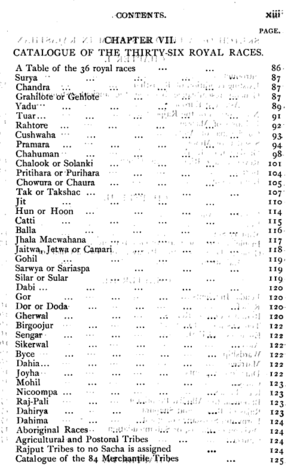36 royal races

The 36 royal races (Chathis Rajkula) is a listing of Indian social groups purported to be the royal (ruling) clans of several states and Janapads spread over northern Indian subcontinent. Among the historical attempts at creating a comprehensive listing of the 36 are the Kumarapala Prabandha of Acharya Jinamandan Gani of 1435 AD,[1] Prithviraj Raso of uncertain date, and Colonel James Tod, writing in 1829.
Kumarapala Prabandha list
The Kumarpal Prabandha list gives 36 clans. It starts with dynasties mentioned in the classics, Ikshvaku, Yadu, Surya and Chandra. It mentions some of the famous Rajput clans: Parmar, Chauhan, Chaulukya (Solanki), Pratihara (these four are sometimes termed Agnikula) Ratt, Chandela and Pala. It also mentions local dynasties like Shilahara, Chapotkata, Nikumbh etc. Many of the names are less known. Notably, it includes the Maurya. Kumarpal Prabandha was consulted by Tod,[2] he refers to it as Kumarpal Charit.[3]
Prithviraj Raso list
The list given in Prithviraj Raso has most of the names given in Kumarapala Prabandha, approximately in the same order. Notably it adds Tank, Abhira and Kalachuri.
Tod's list
A listing of the 36 was attempted by Tod in his 1829 work Annals and Antiquities of Rajasthan (volume 1). The "races" are further subdivided into 157 branches ( i.e. sakhas), and genealogical, cultural, and geographic information given for each, though some of the sakhas are extinct.[4]
The principal ones like the Ghilote having 24 sub-branches, the Tuar or Tanwar 17, the Rathor 13, the Parmara 35, the Chamhan or Chauhan 26, the Challook or Solanki 16, and the Pratihara 12. Each sakha has its Gotracharya of genealogical creed describing the characteristics, religious practices, and the locale of the clan.[5]
As early as 1872, Tod's list was criticised in the Calcutta Review:
It seems a pity that Tod's classification of 36 royal races should be accepted as anything but a purely ornamental arrangement, founded as it was on lists differing considerably both in the numbers and names of the tribes included in it, and containing at least two tribes, the Jats and Gujars, with whom the Rajputs do not even generally intermarry...[6]
Tod listed the Jits as one of the 36 royal races. The Persian form of the ancient term Jit is Jatt (जट्ट) with short vowel and double short ‘t’.[7] The Jats claim to membership has been contested.[8][9] Tod included "Raj Pali" on the list and described them as Aheer or Ahir.[10][11]
References
- ↑ Jai Narayan Asopa (1990). A socio-political and economic study, northern India. Prateeksha Publications. p. 89. Retrieved 26 May 2011.
- ↑ Some Medieval Sculptures of North Gujarat, H. A. Majmudar, Gujarat University, 1968, p. 155
- ↑ Jai Narayan Asopa (1990). A socio-political and economic study, northern India. Prateeksha Publications. p. 94. Retrieved 26 May 2011.
- ↑ Sir Chirravoori Yajneswara Chintamani (1901). Indian social reform: being a collection of essays, addresses, speeches, &c., with an appendix. Thompson. pp. 154–. Retrieved 26 May 2011.
- ↑ Sir Chirravoori Yajneswara Chintamani, "Indian social reform: being a collection of essays, addresses, speeches", page 155
- ↑ University of Calcutta (1872). Calcutta review. University of Calcutta. pp. 386–. Retrieved 26 May 2011.
- ↑ Raza, S. Jabir (2004). The Jats of Punjab and Sind: Their settlements and migrations (c. 5th-12th AD). 1.
- ↑ Royal United Services Institute for Defence Studies (1901). Journal of the Royal United Services Institute for Defence Studies. The Institute. pp. 1488–. Retrieved 26 May 2011.
- ↑ M. S. Naravane; V. P. Malik (1999). The Rajputs of Rajputana: a glimpse of medieval Rajasthan. APH Publishing. pp. 119–. ISBN 978-81-7648-118-2. Retrieved 26 May 2011.
- ↑ Tod, James (1832). "Annales and antiquities of Rajasthan, or the central and western Rajpoot states of Indian". Smith Original : Austrian National Library. p. 443. Retrieved 12 October 2014.
- ↑ Association of Population Geographers of India (1988). "Population Geography: A Journal of the Association of Population Geographers of India, Volume 10, Issues 1-2". The Association Original : the University of California. p. xi. Retrieved 21 June 2017.
External links
- The Thirty-six Royal Races of Rajput at Kipling.org